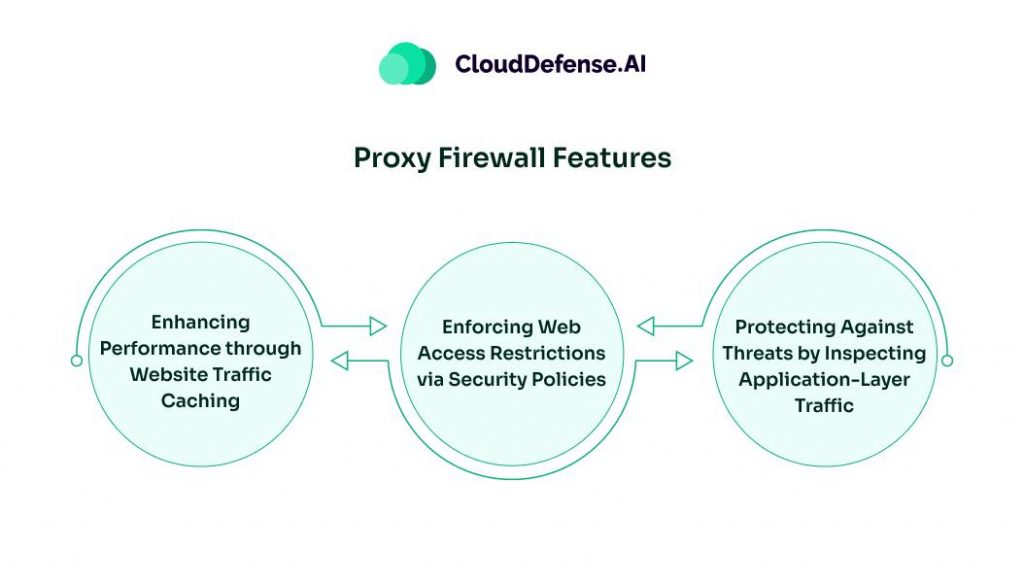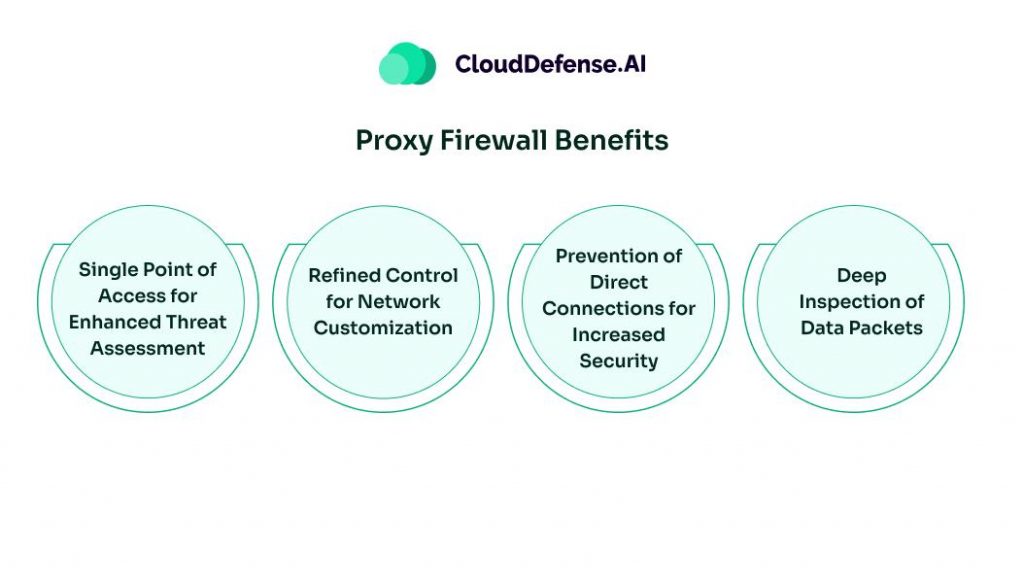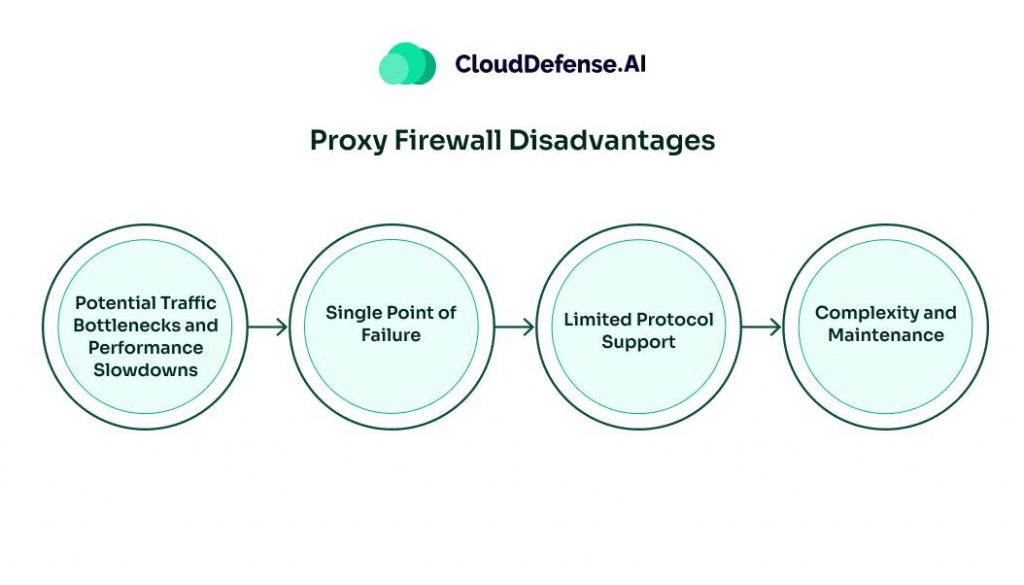What Is a Proxy Firewall?
A proxy firewall, also known as an application firewall or gateway firewall, is a network security device that acts as an intermediary between user requests and the resources they seek to access. By functioning at the application layer, it filters messages and data exchanges to protect network resources, providing a higher level of security compared to traditional firewalls.
How Do Proxy Firewalls Work?
Proxy firewalls function by intercepting all incoming and outgoing traffic between a user’s device and the internet. When a user requests access to a specific resource, the proxy firewall scrutinizes the request, verifies its authenticity, and then establishes a connection to the requested resource on the user’s behalf. This means that the proxy firewall, not the user’s device, directly communicates with the external server, effectively concealing the internal network’s details and addresses from external threats.
Proxy Firewall Features

A proxy firewall offers advanced network protection through a number of key features. These features help to enhance performance and strengthen network security against various threats.
1. Enhancing Performance through Website Traffic Caching
Proxy firewalls are able to cache website traffic, which significantly enhances network performance. When a user requests access to a web page, the proxy firewall stores a copy of the content in its cache. If another user requests the same page, the firewall can deliver the cached content directly without fetching it again from the external server. This reduces the time required to load the page and decreases bandwidth usage, resulting in faster and more efficient network performance for frequently accessed websites.
2. Enforcing Web Access Restrictions via Security Policies
Another critical feature of a proxy firewall is its capacity to restrict web access according to predefined security policies. Administrators can configure the firewall to block access to certain websites or content types deemed inappropriate or harmful. This could include sites known for hosting malware, phishing schemes, or other security threats. By controlling which websites can be accessed, the proxy firewall helps enforce organizational security policies and protects users from accessing potentially dangerous or non-compliant web content.
3. Protecting Against Threats by Inspecting Application-Layer Traffic
The proxy firewall excels at inspecting application-layer traffic to detect and prevent malicious activities. Unlike traditional firewalls, which primarily focus on network and transport layer traffic, a proxy firewall dives deeper into the content of data packets at the application layer. It examines the specifics of web requests, email communications, and other application data to identify and block threats such as malware.
Proxy Firewall Benefits

Proxy firewalls offer a range of benefits that help you to boost your network’s security. By acting as a single point of access, providing refined control for customization, preventing direct user connections to external sites, and performing deep packet inspection, proxy firewalls ensure strong protection against sophisticated threats.
1. Single Point of Access for Enhanced Threat Assessment
The primary advantage of a proxy firewall is its ability to serve as a single point of access for network traffic. This centralized control allows organizations to assess threats posed by various application protocols comprehensively. By examining and validating incoming and outgoing data at this single juncture, a proxy firewall effectively detects and minimizes potential security threats, ensuring that only legitimate traffic is allowed through. This level of scrutiny is critical for maintaining network integrity and protecting sensitive data.
2. Refined Control for Network Customization
A proxy firewall offers refined setup control, enabling organizations to tailor its configuration to their specific network requirements and corporate policies. This customization ensures the firewall aligns perfectly with the organization’s security needs and operational demands. Administrators can fine-tune settings to block unwanted applications, control user access, and implement detailed security policies.
3. Prevention of Direct Connections for Increased Security
By preventing direct connections between users’ computers and external sites, a proxy firewall adds a significant layer of security. This indirect access ensures that internal IP addresses and other sensitive network details are concealed from potential attackers. By acting as an intermediary, the proxy firewall minimizes the risk of external threats infiltrating the internal network.
4. Deep Inspection of Data Packets
One of the most substantial benefits of a proxy firewall is its capability to perform deep inspection of every data packet entering or leaving the network. This thorough analysis detects and blocks sophisticated and high-risk malware attacks that might slip past traditional firewalls. By scrutinizing the content of data packets, the proxy firewall ensures that harmful payloads are identified and neutralized before they can cause damage.
Proxy Firewall Disadvantages

Despite the enhanced security provided by proxy firewalls, they come with several drawbacks. These include potential traffic bottlenecks and performance slowdowns, the risk of a single point of failure, limited protocol support, and the complexity and resource demands of implementation and maintenance.
1. Potential Traffic Bottlenecks and Performance Slowdowns
One major disadvantage of proxy firewalls is that they create a new connection for each incoming and outgoing packet. This process can result in significant traffic bottlenecks, as the firewall needs to inspect and handle each packet individually. The additional processing time required for these inspections can slow down network performance, affecting the speed and efficiency of data transmission. For organizations that require high-speed, real-time data processing, this can be a considerable drawback.
2. Single Point of Failure
By centralizing network traffic through a single point of access, a proxy firewall introduces a single point of failure into the network. If the firewall experiences a malfunction or is compromised, the entire network’s security and functionality can be jeopardized. This reliance on a single device means that any issues with the proxy firewall can potentially disrupt network operations, making it crucial for organizations to implement strong failover and redundancy strategies to minimize this risk.
3. Limited Protocol Support
Another limitation of proxy firewalls is that they may only support specific network protocols. This restriction can limit the range of applications and services that the network can effectively support and secure. Organizations using diverse or proprietary applications may find that a proxy firewall does not accommodate all their needs, necessitating additional security measures or alternative solutions. This can complicate network management and reduce the overall flexibility of the network infrastructure.
4. Complexity and Maintenance
Implementing and maintaining a proxy firewall can be complex and resource-intensive. The detailed configuration required to tailor the firewall to an organization’s specific needs demands a high level of expertise. Additionally, ongoing maintenance is necessary to keep the firewall updated with the latest security protocols and threat intelligence. This can place a significant burden on IT resources, especially for smaller organizations with limited technical staff.
Types of Proxy Firewalls
Proxy firewalls come in various types, each serving different purposes and offering distinct features. Understanding these types helps in selecting the right proxy firewall for specific network needs.
| Type | Definition |
| Reverse Proxy | A reverse proxy is positioned in front of one or more web servers, intercepting incoming requests from the internet. This type of proxy is commonly used for load balancing, distributing incoming traffic across multiple servers to ensure no single server becomes overwhelmed. It also enhances web acceleration by caching content and providing quick access to commonly requested data. |
| Forward Proxy | The forward proxy sits between a user’s computer and the internet, facilitating requests from within an internal network to the external web. This proxy type is often employed for content filtering, blocking access to specific websites based on security policies. It also provides caching functions, storing frequently accessed content to improve load times and reduce bandwidth usage. |
| Transparent Proxy | Also known as an intercepting, inline, or forced proxy, a transparent proxy operates at the network layer without requiring any special configuration on the user’s device. Users are generally unaware of its presence, as it silently intercepts and processes their communications. This type of proxy is useful for content filtering and monitoring, providing seamless security and performance benefits without user intervention. |
| Non-Transparent Proxy | A non-transparent proxy, in contrast, requires explicit configuration on the user’s machine, such as adjusting browser settings. The presence of this proxy is evident to users, who must configure their devices to route traffic through it. Non-transparent proxies are often used for IP masking and content filtering, allowing organizations to control and monitor internet usage while enhancing privacy and security. |
| Anonymous Proxy | An anonymous proxy hides the user’s IP address from the web services being accessed, making the user’s online activities untraceable. This type of proxy is used to maintain user privacy and prevent tracking by websites or online services. By obscuring the user’s identity, anonymous proxies provide a layer of anonymity during web browsing. |
| High Anonymity Proxy | A high anonymity proxy, or elite proxy, offers an even higher level of privacy compared to standard anonymous proxies. It does not send the X-Forwarded-For HTTP header, making it nearly impossible for the destination server to detect that a proxy is being used. This type of proxy ensures that the user’s IP address remains completely hidden, providing maximum anonymity. |
| Distorting Proxy | A distorting proxy provides an incorrect IP address to the web services being accessed. Instead of simply hiding or masking the user’s IP address, it deliberately presents a false one. This approach can be used for privacy or security reasons, adding another layer of deception to protect the user’s actual IP address from being discovered. |
Proxy Firewall vs. Other Firewall Types
This table compares the features and capabilities of proxy firewalls against other firewall types, including traditional, packet filtering, stateful inspection, and next-generation firewalls, highlighting their differences in security, performance, and operational layers.
| Feature | Proxy Firewall | Traditional Firewall | Next-Gen Firewall |
| Layer of Operation | Application Layer | Network/Transport Layer | Network/Transport Layer |
| Request Handling | Evaluates and Relays Requests | Filters traffic based on IP addresses and ports | Combines stateful inspection with advanced features like application awareness and threat intelligence |
| Content Inspection | Deep content inspection, capable of identifying and blocking harmful content | Basic inspection based on defined rules | Deep inspection of packet payloads, uses threat intelligence for detection |
| Privacy and Security | Masks internal IP addresses, preventing direct communication between internal clients and external servers | Provides basic access control | Provides advanced security features and policies, uses integrated intrusion prevention systems |
| Performance Impact | Can introduce latency due to detailed inspection and processing | Generally low latency | Designed for efficient performance while offering advanced security features |
| Caching Capabilities | Can cache web content to improve performance | Does not provide caching capabilities | May include performance enhancements such as caching and QoS |
| Protection Level | High protection against application-level exploits and complex threats. | Basic protection against known threats based on IP and port rules | High protection through comprehensive features like application control, IPS, and dynamic threat response |
Final Words
A proxy firewall is an advanced security solution designed to protect networks by filtering and mediating all application-layer traffic. While offering superior security by preventing direct connections between internal and external networks, it may also introduce some limitations in network speed and application support. Despite these trade-offs, proxy firewalls remain a critical component of a comprehensive network security strategy, especially in environments where protecting sensitive data and preventing unauthorized access are necessary.







